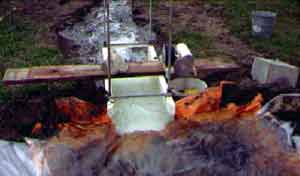
The effects of groundwater pumping on surface water supplies can seldom be measured.
 |
|
The impacts of ground water pumping on surface water bodies can be measured in relatively few situations. Measurable impacts require situations where there is little interference from other wells, close proximity of the pumping location and the surface water, and a pumping rate that is a measurable proportion of stream or spring discharge. If nearby wells exist that have a capacity similar to that of the well of interest, and these wells are operating, it becomes difficult or impossible to isolate the effects of a single well on a nearby spring or stream. If the well of interest is a great distance from the spring or stream (perhaps a few miles or more), the effects may be so greatly attenuated that testing becomes infeasible. If the pumping rate is small relative to the discharge of the stream or spring, then changes in the spring or stream flow may be immeasurably small. Any of these conditions make the measurement of depletion due to pumping impracticable and require that theoretical methods be employed.
Ground water flow theory can be applied to estimate spring or stream depletion in several ways. Some of the most simple techniques were developed by Jenkins (1968) and Glover (1968). These methods use an analytical equation to calculate graphs that generically relate pumping to depletion. Depletion rates are a function of aquifer transmissivity and storativity and the distance between the stream and well. The depletion is assumed to be proportional to the pumping rate. Application of these methods involves numerous simplifying assumptions including: 1) the aquifer is infinite except where cut by the stream, 2) the stream fully penetrates the aquifer, 3) the aquifer characteristics are uniform, 4) the stream is approximately straight, and 5) aquifer thickness is not significantly changed by pumping. When these assumptions are too restrictive, more sophisticated methods must be employed.
Numerical modeling of stream depletion avoids many of the assumptions required in the more simple analytical techniques. Numerical modeling allows us to incorporate all of our understanding (which may be incomplete or flawed) of the real system into the process of calculating depletion. The sophistication of the model should be commensurate with the level of our understanding of the real system. Simple numerical models supported by limited data may still give more accurate estimates than the described analytical methods. Numerical modeling, however, does require more effort than application of the analytical techniques. In cases where entire aquifers are considered, and multiple reaches of streams are interconnected with the aquifer, the modeling process may become very complicated.
In some cases, the results of numerical models may be generically represented by response functions or coefficients. The response functions are determined from numerical models and quantify the relationship between pumping and stream depletion for specific pumping locations and stream reaches. Response functions are being determined to relate depletion of surface flows of the Snake River due to ground water pumping of the Snake River Plain aquifer. For more information on response functions click here.
How
do Surface Water Bodies Respond to Aquifer Recharge?
The previous discussion has focused on the impacts of ground water pumping on
stream and spring discharge. There is an equal and opposite effect for
conditions of aquifer recharge on spring and river flow. As ground water
pumping serves to deplete stream flow, aquifer recharge enhances stream flow.
All of the previous discussion related to pumping also relates to recharge.